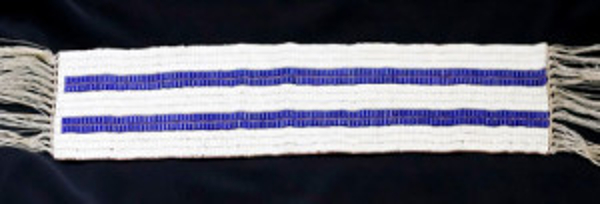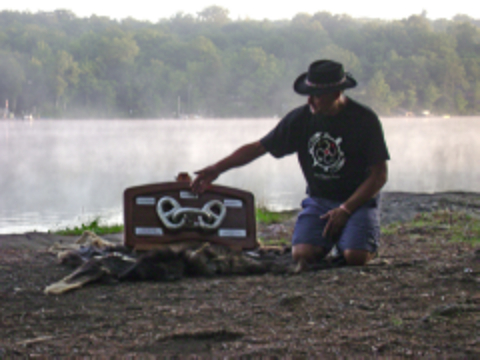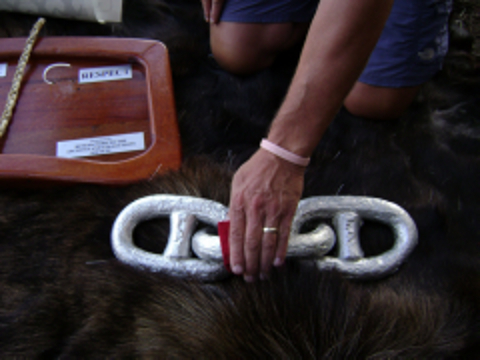
|
Loyalist and Mohawk Exchanges6 June to 6 July, 2009 |
|
Meeting on the River of Life: Two Row Wampum and the Silver Chain
This commentary was written by Bryan Bowers, who served as Chair of the Meeting on the River of Life exhibition. He worked closely with one of our sponsors, the Ontario Provincial Police, who warmly recognized the origins of the treaty meanings of the Two Row Wampum and the Silver Chain as "peace, friendship and respect." It should be noted that our Silver Chain represntation has, since the exhibition, travelled widely – it has been used in schools and universites, as a backdrop to meetings between the Prime Minister and the National Chief of the Assembly of First Nations, and spent over a year at the United Nations in New York.
Historical Artifacts of Treaties: Two Row Wampum Belt and Silver Covenant Chain

A Two Row Wampum belt. Courtesy: onondaganation.org.
As a recent graduate of the FNTI’s Indigenous Community Health Approaches Program (ICHAP), I had come to learn of the Two Row Wampum Treaty belt, which was the indigenous Haudenosaunee expression for how the settler culture and the indigenous culture were to conduct themselves post contact.
The two-row wampum belt is comprised of two purple rows and three white rows. The purple rows signify two distinct rivers running side by side, one river for settler people to sail their ships, and the other river for the indigenous people to paddle their canoes, neither interfering with the other. The three white rows signified a covenant to live side by side in Peace, Respect and Friendship.

Sunrise ceremony, Petroglyphs Provincial Park.

Polishing the Silver Covenant Chain.
Early settlers also made their own expression of the Two Row Wampum Treaty Belt and called it the Silver Covenant Chain. In 1608 the Dutch were the first to express it by using two pieces of rope made from the bark of a tree or its roots. In 1632, the English reaffirmed this expression by using three links of a ship’s iron anchor chain until the 1680s when the British coated those three links of the covenant chain with silver (illustrations 3 and 4) so that they could be polished from time to time to reassert peaceful relations, resolve disputes, and renew peace, respect and friendship between all of North America’s (Turtle Island’s) forefathers, including the Haudenosaunee, Dutch, British and French.
In the first photograph, I am presenting the teachings of the Silver Covenant Chain at a sunrise ceremony at Ontario’s Petroglyphs Provincial Park for the United Church’s “Dancing the Circle of Right Relationships” canoe outing. In the second photograph, I am showing how the Silver Covenant Chain is polished using a red “treaty” cloth. The British even took it one step further by figuratively tying the Silver Covenant Chain to the Iroquois Confederacies’ Tree of Peace. Today there is a Haudenosaunee teaching that says, “should any one follow the Tree of Peace’s white roots to their source, they are welcome to sit with them in its shade. For it is their law of the land.” Thus historically the Silver Covenant Chain served as a tool to establish dialogue between indigenous and settler peoples. Indeed, it became the root of their negotiations. Its brilliance was not only in its simplicity but also in its inherent collaborative nature. People had to become personal with “the other” by putting their hand on the chain to polish it, while sitting across from “the other.”
Sponsorship for resolution.
The question for the OPP and myself then became how to resurrect the Silver Covenant Chain as a possible tool to resolve a potential dispute peacefully. Should we not be looking back to the lessons of history? Could the Silver Covenant Chain be used to break the isolation of each side? And if history had anything to teach us it was about the importance of good relationships, so why would we not try to resurrect it?
The OPP were quickly discovering that they needed to develop a new plan. Their Aboriginal liaison officer’s concerns were that their collective corporate memory would likely forget their progress after things settled down; great tactically but not so good strategically. To their credit they realized they were dealing with an indigenous culture with huge respect for symbolisms that recall stories of historical treaties with the Crown as though they happened yesterday and who consider seven generations as a standard of time. The OPP’s challenge then became how to engage this culture in a strategic project and a partnership. Helping to resurrect the Silver Covenant Chain seemed to meet those strategic and symbolic requirements.
Thus the OPP became a silent partner in the reproduction and resurrection of the Silver Covenant Chain. At the time there were very few people within Tyendinaga that would have ever considered the police to be a partner in such a project. A delicate silent partnership was needed, otherwise the naysayers would discredit any input from the police and the upcoming Meeting on the River of Life would suffer. The liaison officer was subsequently included in all our planning meetings where he reported meeting wonderful people, all with the same vision. It was in those meetings that he learned that the relationship between the indigenous Haudenosaunee and Loyalist settlers was still good, that there were some difficulties, the same as there had always been, but, more importantly, it renewed his faith that once again mutual peace, respect and friendship could be realized. Our planning meetings for the Meeting on the River of Life exhibition were in themselves symbolic exercises in polishing the Silver Covenant Chain and an opportunity for socializing to renew friendships.
Nia:wen / Thank you to the supporters of Meeting on the River of Life.

